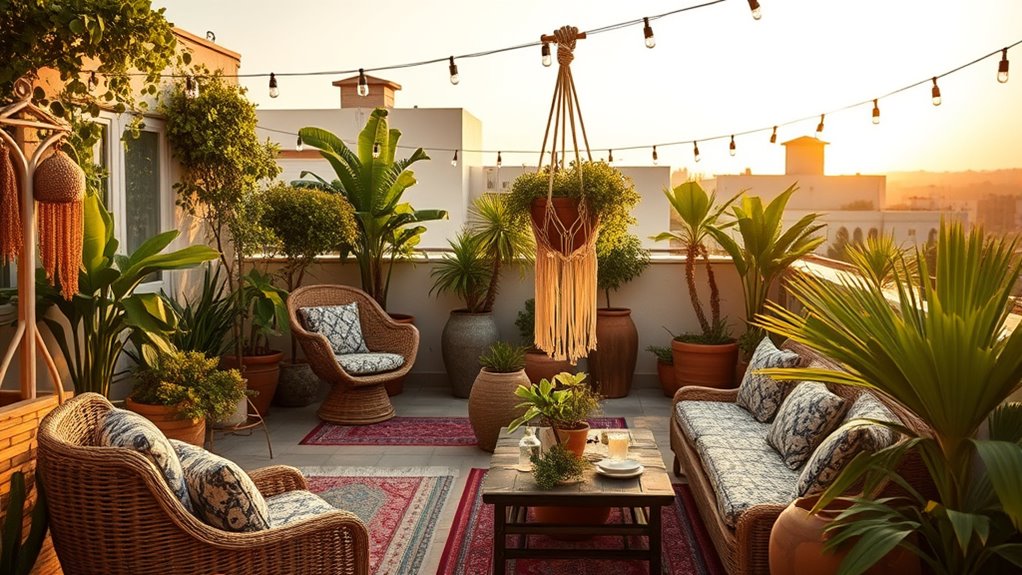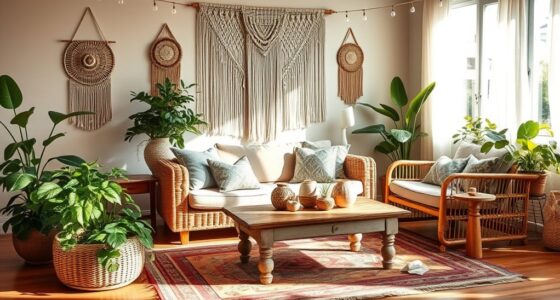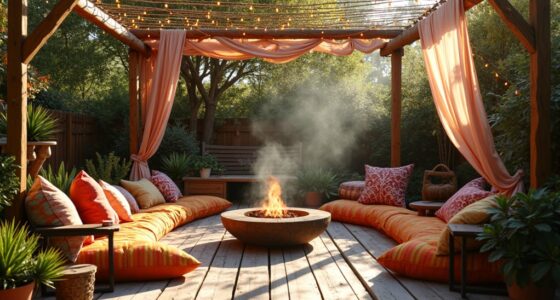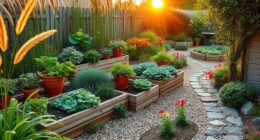To build a boho roof garden or terrace, start by selecting a variety of lush greenery, colorful flowers, and textured plants like succulents for easy care. Arrange layered furniture with comfy cushions, poufs, and vintage accents to create a cozy vibe. Use warm lighting such as fairy lights and lanterns for ambiance. Add personal touches with dreamcatchers and eclectic decor, and choose eco-friendly materials. Keep exploring to discover more tips for transforming your outdoor space into a boho paradise.
Key Takeaways
- Select a variety of plants including greenery, flowering, succulents, and trailing vines for layered, textured landscapes.
- Arrange diverse furniture such as poufs, vintage chairs, and reclaimed wood tables in a cozy, informal layout.
- Incorporate warm lighting like fairy lights, lanterns, and candles to create a inviting ambiance at sunset.
- Use eclectic decor, wall art, and vintage accessories to reflect personality and enhance boho charm.
- Choose sustainable, natural, and recycled materials for furniture, planters, and decor to support eco-friendly design.

Creating a boho roof garden or terrace transforms your outdoor space into a vibrant, relaxed oasis. This style thrives on a mix of eclectic elements, lush greenery, and cozy seating that invites you to unwind. To achieve this look, your first step is carefully considering plant selection. Opt for a variety of greenery, flowering plants, and even small trees to create a layered, textured landscape. Succulents and cacti add a touch of desert charm and are easy to maintain, while hanging planters filled with trailing vines or colorful blooms inject energy and movement into the space. Don’t shy away from mixing different pots, textures, and heights — this diversity is key to capturing the boho aesthetic. Incorporate plants in woven baskets, vintage ceramics, or rustic metal containers to enhance the eclectic vibe. Remember, the goal is to craft a lush, inviting environment that feels natural and slightly whimsical.
Once you’ve chosen your plants, focus on furniture arrangements that complement the relaxed, free-spirited style of a boho terrace. You want seating that’s both functional and visually appealing, encouraging conversation and leisure. Think about layered seating options: a combination of poufs, floor cushions, vintage armchairs, and a comfortable sofa or daybed. Use an assortment of textiles—think fringed throws, patterned cushions, and macramé accents—to add warmth and personality. A low coffee table or side tables made from reclaimed wood or metal can serve as a practical centerpiece without cluttering the space. Arrange your furniture in a cozy, informal layout that promotes easy movement and social interaction. Incorporate a mix of styles and materials—rattan, wicker, ruffled linen, or velvet—to reinforce the boho charm.
Lighting is equally important to enhance the ambiance. String fairy lights or lanterns across the space, creating a warm glow as the sun sets. Place candles or solar-powered lanterns on tables or hanging from hooks to add a magical touch. To make the terrace even more inviting, add a few personal touches like hanging dreamcatchers, wall art, or vintage accessories. These elements don’t just fill space—they tell a story and reflect your personality.
Additionally, incorporating sustainable materials and eco-friendly decor can further elevate the boho aesthetic while supporting environmental consciousness. In essence, building a boho roof garden or terrace is about blending nature with comfort, mixing textures, and creating a space that feels spontaneous yet thoughtfully curated. Your plant choices and furniture arrangements set the foundation for a lively, inviting atmosphere where you can relax, entertain, and enjoy the outdoors at any time of day.
Frequently Asked Questions
How Do I Ensure Proper Drainage for a Roof Garden?
To guarantee proper drainage for your roof garden, start with effective roof drainage solutions like installing a slope that directs water toward drains. Use gutter installation techniques to channel runoff away from the garden area. Regularly clean gutters and check for clogs to prevent water buildup. Incorporate drainage layers beneath your plant beds, and consider adding a waterproof membrane to protect your roof from water damage.
What Are the Best Plants for Windy Rooftop Environments?
Wind-resistant plants withstand whipping winds and weather the elements, making them perfect for your rooftop. Focus on low-maintenance species like succulents, sedums, and hardy grasses that thrive despite the turbulent temps. These tough, drought-tolerant types not only stand strong against the breeze but also require minimal care, ensuring your garden remains gorgeous without constant upkeep. With the right selection, your rooftop oasis will flourish, free from wind worries.
How Can I Waterproof the Roof Before Installing a Garden?
You should start by inspecting your roof and cleaning the surface thoroughly. Then, apply a high-quality roof membrane designed for waterproofing, ensuring it covers the entire area without gaps. For extra protection, add waterproof coatings over the membrane, especially around seams and edges. This layered approach prevents water infiltration, keeps your garden safe, and prolongs your roof’s lifespan. Always follow manufacturer instructions for the best results.
What Safety Precautions Are Needed During Construction?
You should prioritize roof safety by wearing proper protective gear, including helmets, gloves, and non-slip shoes. Always secure the work area to prevent falls, and use safety harnesses when working at heights. Be aware of construction hazards like falling debris or unstable surfaces, and guarantee all equipment is in good condition. Regularly inspect your setup and follow safety protocols to protect yourself and others during construction.
How Do I Access the Roof Garden Safely?
To access your roof garden safely, you should use a secure, stable ladder or stairway designed for rooftop access safety. Always verify the access point is in good condition, with handrails and non-slip surfaces. Before entering, check for any hazards or unstable areas. Keep the access route clear of debris, and consider installing safety features like guardrails or a rooftop hatch lock to prevent accidental falls.
Conclusion
Creating a boho roof garden transforms your outdoor space into a vibrant retreat, boosting your well-being and home value. Did you know that rooftop gardens can reduce urban heat by up to 20%? Imagine relaxing in your personalized oasis while making a positive environmental impact. With a little creativity and effort, you’ll enjoy a stunning, sustainable space that elevates your lifestyle and benefits the planet—your perfect escape is just a rooftop away.









